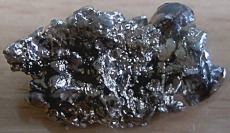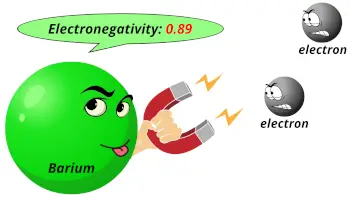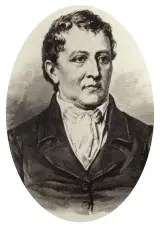
This is a SUPER easy guide on Barium element.
In fact, the table mentioned below is the perfect information box (Which gives you every single detail about the Barium element in Periodic table.)
So if you want to know anything about Barium element, then this guide is for you.
Let’s finish this very quickly.
Barium Element (Ba) Information
| Appearance |  Silvery gray metallic luster with a pale yellow tint |
| State (at STP) | Solid |
| Position in Periodic table |  Group: 2, Period: 6, Block: s |
| Category |  Alkaline earth metals |
| Atomic number or Protons | 56 |
| Neutrons | 81 |
| Electrons | 56 |
| Symbol | Ba |
| Atomic mass |  137.33 u |
| Electrons arrangement or Bohr model |  2, 8, 18, 18, 8, 2 |
| Electronic configuration | [Xe] 6s2 |
| Atomic radius |  268 picometers (van der Waals radius) |
| Valence electrons |  2 |
| 1st Ionization energy | 5.212 eV |
| Electronegativity |  0.89 (Pauling scale) |
| Crystal structure |  BCC (Body centered cubic) |
| Melting point | 1000 K or 727 °C or 1341 °F |
| Boiling point | 2118 K or 1845 °C or 3353 °F |
| Density | 3.51 g/cm3 |
| Main isotope | 138Ba |
| Who discovered Barium and when? |  Carl Wilhelm Scheele in 1772 |
| CAS number | 7440-39-3 |
Barium in Periodic table
Barium element is in group 2 and period 6 of the Periodic table. Barium is the s-block element and it belongs to alkaline earth metals group.
| H | He | ||||||||||||||||
| Li | Be | B | C | N | O | F | Ne | ||||||||||
| Na | Mg | Al | Si | P | S | Cl | Ar | ||||||||||
| K | Ca | Sc | Ti | V | Cr | Mn | Fe | Co | Ni | Cu | Zn | Ga | Ge | As | Se | Br | Kr |
| Rb | Sr | Y | Zr | Nb | Mo | Tc | Ru | Rh | Pd | Ag | Cd | In | Sn | Sb | Te | I | Xe |
| Cs | Ba | La* | Hf | Ta | W | Re | Os | Ir | Pt | Au | Hg | Tl | Pb | Bi | Po | At | Rn |
| Fr | Ra | Ac** | Rf | Db | Sg | Bh | Hs | Mt | Ds | Rg | Cn | Nh | Fl | Mc | Lv | Ts | Og |
| *Ce | Pr | Nd | Pm | Sm | Eu | Gd | Tb | Dy | Ho | Er | Tm | Yb | Lu | ||||
| **Th | Pa | U | Np | Pu | Am | Cm | Bk | Cf | Es | Fm | Md | No | Lr |
←Move to: Cesium (Cs) element – Periodic Table
→Move to: Lanthanum (La) element – Periodic Table
Why is Barium in Group 2?

Do you know, how many electrons can be accommodated in the first shell, second shell, third shell, fourth shell, etc…?
Here is the table showing the capacity of orbits to hold electrons.
Number of electrons in shells.
| Orbit / Shell (n) | Maximum no. of electrons this orbit can hold (2 × n2) |
| K shell, n = 1 | 2 × 1² = 2 |
| L shell, n = 2 | 2 × 2² = 8 |
| M shell, n = 3 | 2 × 3² = 18 |
| N shell, n = 4 | 2 × 4² = 32 |
| . . . | . . . |
Thus,
- 1st shell can hold 2 electrons.
- 2nd shell can hold 8 electrons.
- 3rd shell can hold 18 electrons.
- 4th shell can hold 32 electrons, and so on.
Now the atomic number of barium (Ba) is 56.
Hence the electron arrangement in barium is 2, 8, 18, 18, 8, 2. This electron arrangement indicates that the outermost orbit (i.e orbit number 6) of barium atom has 2 electrons.
Hence, it lies in group 2.
Why is Barium in Period 6?

Let me ask you a question.
How many shells does barium have?
It’s 6. Right?
You have already seen the bohr model of barium atom in the above table.
From the Bohr model, it can be found that the number of orbits or shells in barium is 6. Hence, as barium has 6 orbits, it lies in period 6 of the Periodic table.
Why is Barium in s-block?

Before knowing this reason, first of all I want to ask you a simple question.
How can you determine the blocks-wise position of elements?
The simple answer: The elements will lie in the s, p, d or f block will completely depend upon the subshell in which the last electron will enter.
For example; the electron configuration of barium is [Xe] 6s2.
So the last electron of barium enters the s-subshell or s-orbital.
Hence, barium is the s-block element.
5 Interesting facts about Barium
Interesting facts about barium element are mentioned below.
- The name barium was derived from the Greek word “barys”, which means heavy.
- Barium was discovered by Carl Wilhelm Scheele in 1772 and it was first isolated by Humphry Davy in the year 1808.
- Barium makes up around 0.05 % of the earth crust.
- Barium is the 17th most abundant element present in the earth’s crust.
- Barium is also present in the human body which is obtained from foods like onion, beans, carrots, etc.
Properties of Barium
The physical and chemical properties of barium element are mentioned below.
Physical properties of Barium
Physical properties of barium are mentioned below.
- Barium is a soft metal having silvery grey metallic lustre with a pale yellow tint.
- The melting point of barium is 727 °C and its boiling point is 1845 °C.
- The atomic mass of barium is 137.33 u and its density is 3.51 g/cm3, which is quite dense among all the other alkaline earth metals on the periodic table.
- The crystal structure of barium is BCC (Body centered cubic).
- Barium has many isotopes, but out of those isotopes, the isotope 138Ba is the most abundant one (approximately 71.7 %).
Chemical properties of Barium
Chemical properties of barium are mentioned below.
- Barium is a chemically reactive metal and hence it is not found in its free state. It is always in a compound form with other elements.
- Barium has 2 valence electrons and it loses these 2 electrons during a chemical reaction to become stable.
- When barium is kept open in air, it quickly reacts with oxygen and produces barium oxide. (Because of this reason, barium is stored in mineral oil.)
- Barium reacts with water to form barium hydroxide and during this reaction, hydrogen gas is liberated.
- The first ionization energy of barium is 5.212 eV.
Uses of Barium
Uses of barium are mentioned below.
- Barium is highly reactive to oxygen and hence it is used in removing the last traces of oxygen from the vacuum tubes.
- Barium is also used as an alloy in making some engine parts like spark plug, bearings, etc.
- Barium sulfate (which is a compound of barium), is used in making rubber, glass, as well as in well drilling fluids.
- Barium compounds like barium nitrate and barium chlorate are used in fireworks which produce green color.
- As barium is a heavier metal, it is also used in X-rays. This is because heavier elements can easily absorb X-rays.
Explore our New Interactive Periodic Table (with Rotating Bohr Models and More)

Details about this Periodic table:
- Access detailed info on all elements: atomic mass, electron configurations, charges, and more.
- View rotating Bohr models for all 118 elements.
- Get a free HD image of the Periodic Table.
Note: For future use, bookmark this Periodic table or visit “PeriodicTableGuide.com”
External resources:
- Barium – Wikipedia. (2020, November 24). Barium – Wikipedia. https://en.wikipedia.org/wiki/Barium
- Barium – Element information, properties and uses | Periodic Table. (n.d.). Barium – Element Information, Properties and Uses | Periodic Table. https://www.rsc.org/periodic-table/element/56/barium
- P. (n.d.). Barium | Ba (Element) – PubChem. Barium | Ba (Element) – PubChem. https://pubchem.ncbi.nlm.nih.gov/element/Barium
- It’s Elemental – The Element Barium. (n.d.). It’s Elemental – the Element Barium. https://education.jlab.org/itselemental/ele056.html
- Periodic Table of Elements: Los Alamos National Laboratory. (n.d.). Periodic Table of Elements: Los Alamos National Laboratory. https://periodic.lanl.gov/56.shtml
